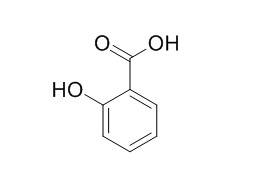Salicylic acid
Salicylic acid , a phenolic phytohormone, can alleviate the damaging effects of the triple stress by improving the antioxidant system, although these effects differed depending on characteristic of the hull of the grain. Salicylic acid plays a key role in regulation of plant immune responses to different attackers.
Inquire / Order:
manager@chemfaces.com
Technical Inquiries:
service@chemfaces.com
Tel:
+86-27-84237783
Fax:
+86-27-84254680
Address:
1 Building, No. 83, CheCheng Rd., Wuhan Economic and Technological Development Zone, Wuhan, Hubei 430056, PRC
Providing storage is as stated on the product vial and the vial is kept tightly sealed, the product can be stored for up to
24 months(2-8C).
Wherever possible, you should prepare and use solutions on the same day. However, if you need to make up stock solutions in advance, we recommend that you store the solution as aliquots in tightly sealed vials at -20C. Generally, these will be useable for up to two weeks. Before use, and prior to opening the vial we recommend that you allow your product to equilibrate to room temperature for at least 1 hour.
Need more advice on solubility, usage and handling? Please email to: service@chemfaces.com
The packaging of the product may have turned upside down during transportation, resulting in the natural compounds adhering to the neck or cap of the vial. take the vial out of its packaging and gently shake to let the compounds fall to the bottom of the vial. for liquid products, centrifuge at 200-500 RPM to gather the liquid at the bottom of the vial. try to avoid loss or contamination during handling.
Int J Mol Sci.2023, 24(24):17589.
Indian J Pharm Sci.2022, 84(4): 874-882.
J Food Drug Anal.2023, 31(2):254-277.
Phytomedicine.2020, 153440.
Applied Food Research2024, 100662.
Front Nutr.2023, 10:1168095.
ScientificWorldJournal.2022, 2022:4806889.
Hum Exp Toxicol.2017, 36(11):1169-1176
J Adv Res.2021, 35:245-257.
J Cell Mol Med.2024, 28(16):e70016.
Related and Featured Products
Physiol Plant. 2018 Jul 9.
Time-course analysis of salicylic acid effects on ROS regulation and antioxidant defense in roots of hulled and hulless barley under combined stress of drought, heat and salinity.[Pubmed:
29984429]
Greater crop losses can result from simultaneous exposure to a combination of drought, heat and salinity in the field. Salicylic acid (SA), a phenolic phytohormone, can affect a range of physiological and biochemical processes in plants and significantly impacts their resistance to these abiotic stresses. Despite numerous reports involving the positive effects of SA by applying each abiotic stress separately, the mechanism of SA-mediated adaptation to combined stresses remains elusive.
METHODS AND RESULTS:
This study, via a time-course analysis, investigated the role of SA on the roots of hulled and hulless (naked) barley (Hordeum vulgare L. 'Tarm' and 'Özen', respectively), which differed in salt tolerance, under the combined stress of drought, heat and salt. The combined stress caused marked reductions in root length and increases in proline content in both genotypes; however, Tarm exhibited better adaptation to the triple stress. Under the first 24 h of stress, superoxide dismutase (SOD; EC.1.15.1.1) and peroxidase (POX; EC.1.11.1.7) activity in the Tarm roots increased remarkably, while decreasing in the Özen roots. Furthermore, the Tarm roots showed higher catalase (CAT; EC 1.11.1.6), ascorbate peroxidase (APX; EC 1.11.1.11) and glutathione reductase (GR; EC 1.6.4.2) activity than the Özen during the combined stresses. The sensitivity of hulless barley roots may be related to decreasing SOD, POX, CAT and GR activity under stress. Over 72 h of stress, the SA pretreatment improved the APX and GR activity in Tarm and that of POX and CAT in Özen, demonstrating that exogenously applied SA regulates antioxidant defense enzymes in order to detoxify ROS. The results of this study suggest that SA treatment may improve the triple-stress combination tolerance in hulled and hulless barley cultivars by increasing the level of antioxidant enzyme activity and promoting the accumulation of proline.
CONCLUSIONS:
Thus, SA alleviated the damaging effects of the triple stress by improving the antioxidant system, although these effects differed depending on characteristic of the hull of the grain.
AoB Plants. 2018 May 16;10(3):ply031.
Defence signalling marker gene responses to hormonal elicitation differ between roots and shoots.[Pubmed:
29977487 ]
Phytohormones such as jasmonic acid (JA), Salicylic acid (SA), ethylene (ET) and abscisic acid (ABA) play a key role in regulation of plant immune responses to different attackers. Extensive research over recent years has led to the identification of molecular markers for specific hormonal-regulated defence pathways. However, most of our current knowledge on the regulation of plant immunity derives from studies focused on above-ground organs, mainly on the model plant Arabidopsis thaliana. Therefore, it is unclear whether the paradigms based on experiments on above-ground organs are entirely transferable to roots.
METHODS AND RESULTS:
Here, we used the non-model plant Brassica rapa to study the regulation dynamics of hormonal-related marker genes in both roots and shoots. These markers were identified in Arabidopsis shoots after elicitation of the JA-, SA-, ET- or ABA-signalling pathways, and are commonly used to study induced responses. We assessed whether the regulation of those genes by hormonal elicitation differs between roots and shoots. To discern whether the differences in marker gene expression between roots and shoots are related to differences in hormone production or to differential responsiveness, we also measured actual hormone content in the treated tissue after elicitation. Our results show that some of the widely used markers did not show specific responsiveness to single hormone applications in B. rapa. We further found that hormonal elicitation led to different response patterns of the molecular markers in shoots and roots.
CONCLUSIONS:
Our results suggest that the regulation of some hormonal-related marker genes in B. rapa is organ specific and differs from the Arabidopsis-derived paradigms.



